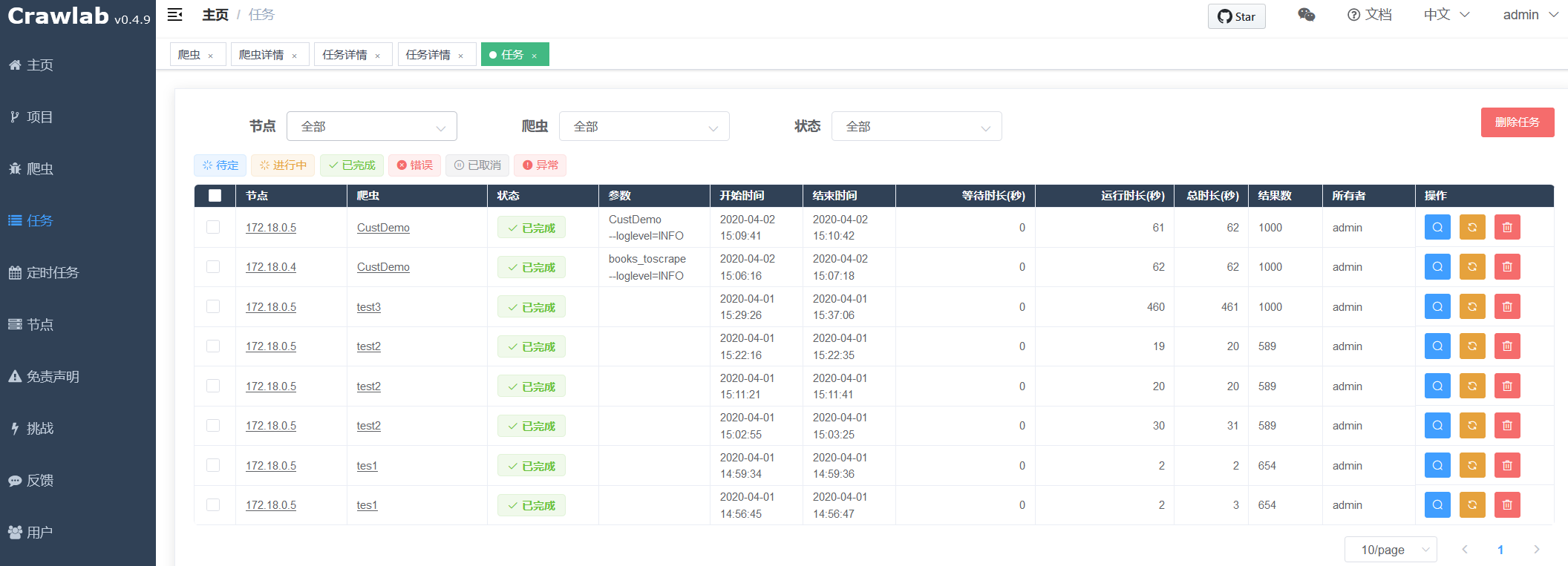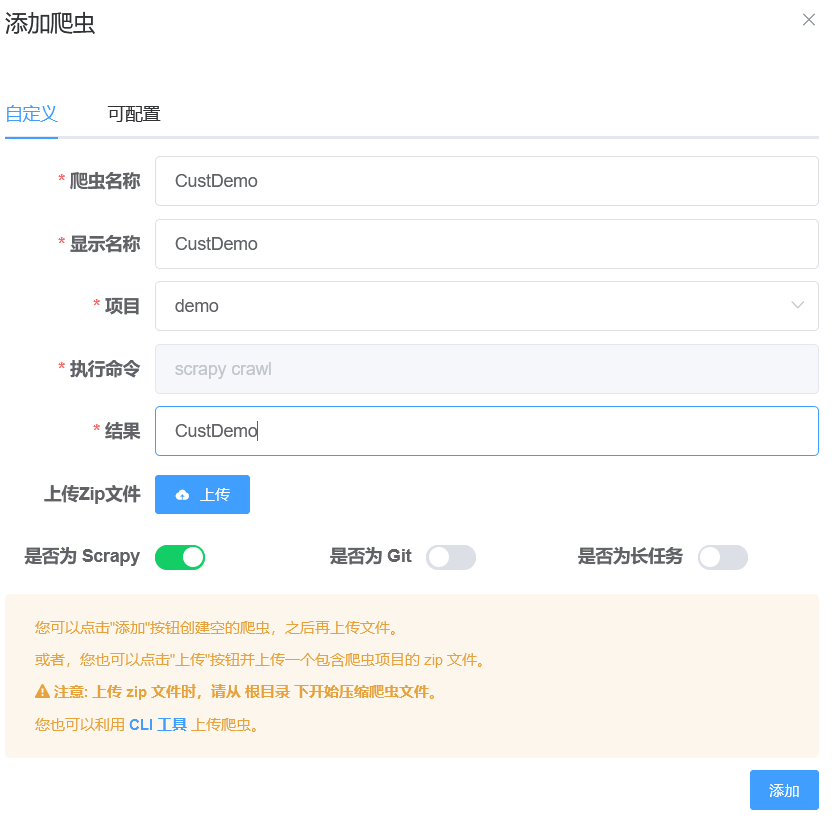Windows 安装 docker:
https://www.docker.com/products/docker-desktop
安装python环境:
我选 Pycharm+Anaconda
安装docker-compose:
pip install docker-compose
创建项目文件:docker-compose.yml
启动:
docker-compose up -d
测试服务:
http://localhost:8080/

- docker-compose.yml
version: '3.3'
services:
master:
image: tikazyq/crawlab:latest
container_name: master
environment:
# CRAWLAB_API_ADDRESS: "https://<your_api_ip>:<your_api_port>" # backend API address 后端 API 地址. 适用于 https 或者源码部署
CRAWLAB_SERVER_MASTER: "Y" # whether to be master node 是否为主节点,主节点为 Y,工作节点为 N
CRAWLAB_MONGO_HOST: "mongo" # MongoDB host address MongoDB 的地址,在 docker compose 网络中,直接引用服务名称
# CRAWLAB_MONGO_PORT: "27017" # MongoDB port MongoDB 的端口
# CRAWLAB_MONGO_DB: "crawlab_test" # MongoDB database MongoDB 的数据库
# CRAWLAB_MONGO_USERNAME: "username" # MongoDB username MongoDB 的用户名
# CRAWLAB_MONGO_PASSWORD: "password" # MongoDB password MongoDB 的密码
# CRAWLAB_MONGO_AUTHSOURCE: "admin" # MongoDB auth source MongoDB 的验证源
CRAWLAB_REDIS_ADDRESS: "redis" # Redis host address Redis 的地址,在 docker compose 网络中,直接引用服务名称
# CRAWLAB_REDIS_PORT: "6379" # Redis port Redis 的端口
# CRAWLAB_REDIS_DATABASE: "1" # Redis database Redis 的数据库
# CRAWLAB_REDIS_PASSWORD: "password" # Redis password Redis 的密码
# CRAWLAB_LOG_LEVEL: "info" # log level 日志级别. 默认为 info
# CRAWLAB_LOG_ISDELETEPERIODICALLY: "N" # whether to periodically delete log files 是否周期性删除日志文件. 默认不删除
# CRAWLAB_LOG_DELETEFREQUENCY: "@hourly" # frequency of deleting log files 删除日志文件的频率. 默认为每小时
# CRAWLAB_SERVER_REGISTER_TYPE: "mac" # node register type 节点注册方式. 默认为 mac 地址,也可设置为 ip(防止 mac 地址冲突)
# CRAWLAB_SERVER_REGISTER_IP: "127.0.0.1" # node register ip 节点注册IP. 节点唯一识别号,只有当 CRAWLAB_SERVER_REGISTER_TYPE 为 "ip" 时才生效
# CRAWLAB_TASK_WORKERS: 8 # number of task executors 任务执行器个数(并行执行任务数)
# CRAWLAB_RPC_WORKERS: 16 # number of RPC workers RPC 工作协程个数
# CRAWLAB_SERVER_LANG_NODE: "Y" # whether to pre-install Node.js 预安装 Node.js 语言环境
# CRAWLAB_SERVER_LANG_JAVA: "Y" # whether to pre-install Java 预安装 Java 语言环境
# CRAWLAB_SETTING_ALLOWREGISTER: "N" # whether to allow user registration 是否允许用户注册
# CRAWLAB_SETTING_ENABLETUTORIAL: "N" # whether to enable tutorial 是否启用教程
# CRAWLAB_NOTIFICATION_MAIL_SERVER: smtp.exmaple.com # STMP server address STMP 服务器地址
# CRAWLAB_NOTIFICATION_MAIL_PORT: 465 # STMP server port STMP 服务器端口
# CRAWLAB_NOTIFICATION_MAIL_SENDEREMAIL: admin@exmaple.com # sender email 发送者邮箱
# CRAWLAB_NOTIFICATION_MAIL_SENDERIDENTITY: admin@exmaple.com # sender ID 发送者 ID
# CRAWLAB_NOTIFICATION_MAIL_SMTP_USER: username # SMTP username SMTP 用户名
# CRAWLAB_NOTIFICATION_MAIL_SMTP_PASSWORD: password # SMTP password SMTP 密码
ports:
- "8080:8080" # frontend port mapping 前端端口映射
depends_on:
- mongo
- redis
# volumes:
# - "/var/crawlab/log:/var/logs/crawlab" # log persistent 日志持久化
worker:
image: tikazyq/crawlab:latest
container_name: worker
environment:
CRAWLAB_SERVER_MASTER: "N"
CRAWLAB_MONGO_HOST: "mongo"
CRAWLAB_REDIS_ADDRESS: "redis"
depends_on:
- mongo
- redis
# environment:
# MONGO_INITDB_ROOT_USERNAME: username
# MONGO_INITDB_ROOT_PASSWORD: password
# volumes:
# - "/var/crawlab/log:/var/logs/crawlab" # log persistent 日志持久化
mongo:
image: mongo:latest
restart: always
# volumes:
# - "/opt/crawlab/mongo/data/db:/data/db" # make data persistent 持久化
# ports:
# - "27017:27017" # expose port to host machine 暴露接口到宿主机
redis:
image: redis:latest
restart: always
# command: redis-server --requirepass "password" # set redis password 设置 Redis 密码
# volumes:
# - "/opt/crawlab/redis/data:/data" # make data persistent 持久化
# ports:
# - "6379:6379" # expose port to host machine 暴露接口到宿主机
# splash: # use Splash to run spiders on dynamic pages
# image: scrapinghub/splash
# container_name: splash
# ports:
# - "8050:8050"
- 安装CLI
pip install crawlab-sdk
- Scrapy项目
生成Scrapy项目:
scrapy startproject CustDemo
生成爬虫:
scrapy genspider -t basic CustDemo baidu.com
爬虫模板:
Available templates:
basic
crawl
csvfeed
xmlfeed
启动爬虫:
scrapy crawl CustDemo
- CustDemo.py
# -*- coding: utf-8 -*-
import scrapy
import re
from CustDemo.items import Item
from urllib.parse import urljoin, urlparse
def get_real_url(response, url):
if re.search(r'^https?', url):
return url
elif re.search(r'^\/\/', url):
u = urlparse(response.url)
return u.scheme + url
return urljoin(response.url, url)
class BooksToscrapeSpider(scrapy.Spider):
name = 'books_toscrape'
allowed_domains = ['books.toscrape.com']
start_urls = ['http://books.toscrape.com/']
def start_requests(self):
yield scrapy.Request(url='http://books.toscrape.com', callback=self.parse_list)
def parse_list(self, response):
prev_item = response.meta.get('item')
for elem in response.css('section article.product_pod'):
item = Item()
item['title'] = elem.css('h3 > a::text').extract_first()
item['url'] = elem.css('h3 > a::attr("href")').extract_first()
item['price'] = elem.css('.product_price > .price_color::text').extract_first()
if prev_item is not None:
for key, value in prev_item.items():
item[key] = value
yield scrapy.Request(url=get_real_url(response, item['url']), callback=self.parse_detail, meta={'item': item})
next_url = response.css('ul.pager li.next a::attr("href")').extract_first()
yield scrapy.Request(url=get_real_url(response, next_url), callback=self.parse_list, meta={'item': prev_item})
def parse_detail(self, response):
item = Item() if response.meta.get('item') is None else response.meta.get('item')
item['description'] = response.css('#product_description + p::text').extract_first()
yield item
- items.py
# -*- coding: utf-8 -*-
# Define here the models for your scraped items
#
# See documentation in:
# https://docs.scrapy.org/en/latest/topics/items.html
import scrapy
class Item(scrapy.Item):
_id = scrapy.Field()
task_id = scrapy.Field()
ts = scrapy.Field()
title = scrapy.Field()
url = scrapy.Field()
price = scrapy.Field()
description = scrapy.Field()
- settings.py
# -*- coding: utf-8 -*-
# Scrapy settings for CustDemo project
#
# For simplicity, this file contains only settings considered important or
# commonly used. You can find more settings consulting the documentation:
#
# https://docs.scrapy.org/en/latest/topics/settings.html
# https://docs.scrapy.org/en/latest/topics/downloader-middleware.html
# https://docs.scrapy.org/en/latest/topics/spider-middleware.html
BOT_NAME = 'CustDemo'
SPIDER_MODULES = ['CustDemo.spiders']
NEWSPIDER_MODULE = 'CustDemo.spiders'
ITEM_PIPELINES = {
'crawlab.pipelines.CrawlabMongoPipeline': 888,
}
# Crawl responsibly by identifying yourself (and your website) on the user-agent
#USER_AGENT = 'CustDemo (+http://www.yourdomain.com)'
# Obey robots.txt rules
# ROBOTSTXT_OBEY = True
# Configure maximum concurrent requests performed by Scrapy (default: 16)
#CONCURRENT_REQUESTS = 32
# Configure a delay for requests for the same website (default: 0)
# See https://docs.scrapy.org/en/latest/topics/settings.html#download-delay
# See also autothrottle settings and docs
#DOWNLOAD_DELAY = 3
# The download delay setting will honor only one of:
#CONCURRENT_REQUESTS_PER_DOMAIN = 16
#CONCURRENT_REQUESTS_PER_IP = 16
# Disable cookies (enabled by default)
#COOKIES_ENABLED = False
# Disable Telnet Console (enabled by default)
#TELNETCONSOLE_ENABLED = False
# Override the default request headers:
#DEFAULT_REQUEST_HEADERS = {
# 'Accept': 'text/html,application/xhtml+xml,application/xml;q=0.9,*/*;q=0.8',
# 'Accept-Language': 'en',
#}
# Enable or disable spider middlewares
# See https://docs.scrapy.org/en/latest/topics/spider-middleware.html
#SPIDER_MIDDLEWARES = {
# 'CustDemo.middlewares.CustdemoSpiderMiddleware': 543,
#}
# Enable or disable downloader middlewares
# See https://docs.scrapy.org/en/latest/topics/downloader-middleware.html
#DOWNLOADER_MIDDLEWARES = {
# 'CustDemo.middlewares.CustdemoDownloaderMiddleware': 543,
#}
# Enable or disable extensions
# See https://docs.scrapy.org/en/latest/topics/extensions.html
#EXTENSIONS = {
# 'scrapy.extensions.telnet.TelnetConsole': None,
#}
# Configure item pipelines
# See https://docs.scrapy.org/en/latest/topics/item-pipeline.html
#ITEM_PIPELINES = {
# 'CustDemo.pipelines.CustdemoPipeline': 300,
#}
# Enable and configure the AutoThrottle extension (disabled by default)
# See https://docs.scrapy.org/en/latest/topics/autothrottle.html
#AUTOTHROTTLE_ENABLED = True
# The initial download delay
#AUTOTHROTTLE_START_DELAY = 5
# The maximum download delay to be set in case of high latencies
#AUTOTHROTTLE_MAX_DELAY = 60
# The average number of requests Scrapy should be sending in parallel to
# each remote server
#AUTOTHROTTLE_TARGET_CONCURRENCY = 1.0
# Enable showing throttling stats for every response received:
#AUTOTHROTTLE_DEBUG = False
# Enable and configure HTTP caching (disabled by default)
# See https://docs.scrapy.org/en/latest/topics/downloader-middleware.html#httpcache-middleware-settings
#HTTPCACHE_ENABLED = True
#HTTPCACHE_EXPIRATION_SECS = 0
#HTTPCACHE_DIR = 'httpcache'
#HTTPCACHE_IGNORE_HTTP_CODES = []
#HTTPCACHE_STORAGE = 'scrapy.extensions.httpcache.FilesystemCacheStorage'
-
zip压缩项目
两个文件一起打包到CustDemo.zip
-
Crawlab上web部署自定Spider

-
Crawlab上CLI部署自定Spider
没有尝试,因为部署后就需要在web上看结果的,所以直接web部署了 -
结果


-
总结
Crawlab最大的作用可以分布式部署;
其次是可图形化看到结果;
来源:oschina
链接:https://my.oschina.net/lsfx/blog/3217463



